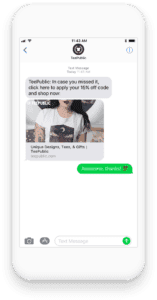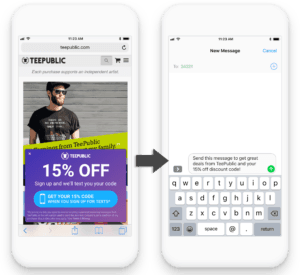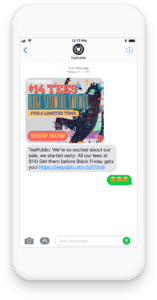T-Shirt retailer TeePublic knew it needed to better cater to its mobile shoppers.
Traffic to the web-only merchant was split 60% mobile and 40% desktop, yet mobile sales were only 30-35% of its overall business, says Adam Lasky, director of marketing for TeePublic.
“We are seeing that gap between users coming to our site via mobile, but they are just not converting,” Lasky says.
 The retailer decided to use SMS as a new communication channel to cater to its mobile-savvy audience. “We wanted to meet users where they are at and how they are engaged with us, and they are engaging with us on their phones,” Lasky says.
The retailer decided to use SMS as a new communication channel to cater to its mobile-savvy audience. “We wanted to meet users where they are at and how they are engaged with us, and they are engaging with us on their phones,” Lasky says.
Since launching in May 2017, 50,000 shoppers have signed up for the SMS program, and 40,000 shoppers still receive the messages, Lasky says. Now, the retailer typically gets around 1,500 new SMS subscribers each week, he says. TeePublic encourages shoppers to sign up for texts via an overlay on the mobile home page, offering 15% off if consumers sign up. TeePublic uses mobile messaging vendor Attentive Mobile Inc. for its SMS program.
After less than a year with the program, Lasky is extremely pleased with the results, especially when comparing the program to email marketing. Text message subscribers have a 25% click-through rate to the web compared with 9% for email subscribers.
Plus, the conversion rate for text messages is roughly 9% compared with 4% for email. “These subscribers are pretty valuable,” Lasky says.
One reason for such a strong response from the SMS channel is that when a shopper receives a text alert on her smartphone, she is more likely to check it, whereas she may not get alerts from her email service provider, Lasky says.
Plus, a shopper’s inbox is likely cluttered, and TeePublic’s email has to compete with all other promotional emails, he says.
“Everyone has signed up for an email list at one point, or they are kind of dormant or passively subscribed,” Lasky says.
“With text messages, we are front and center,” he adds.
 SMS is now a top marketing channel for TeePublic in terms of generating revenue. Mobile sales between May 2017-March 2018 grew 47% more than mobile sales between May 2016-March 2017, Lasky says.
SMS is now a top marketing channel for TeePublic in terms of generating revenue. Mobile sales between May 2017-March 2018 grew 47% more than mobile sales between May 2016-March 2017, Lasky says.
Text marketing also is important for one of TeePublic’s core customer groups, millennials, who are more than half of its shoppers, Lasky says. Millennial consumers’ email open rates are roughly 15% lower than its other shoppers, he says.
TeePublic sends out roughly 10 text messages to shoppers per month, which includes automated texts about order confirmation and shipping detail information.
Another reason that its text messages convert so well is because they are short and to the point, he says. For its email marketing messages, TeePublic has more information such as cost comparisons and why its products are better. Its texts are relaxed, drive urgency and cater to a short attention span, Lasky says. For example, the retailer will include phrases such as “while supplies last” and “for a limited time.”
 Texting also has proved to be an effective customer service channel for TeePublic. Initially, the retailer launched the SMS program to drive sales; however, shoppers began texting TeePublic back, and the retailer realized that customer service is a natural extension of this service, Lansky says.
Texting also has proved to be an effective customer service channel for TeePublic. Initially, the retailer launched the SMS program to drive sales; however, shoppers began texting TeePublic back, and the retailer realized that customer service is a natural extension of this service, Lansky says.
The retailer synced the Attentive platform with its customer service software from Zendesk Inc., so TeePublic’s human customer service representatives can respond to shoppers if they text TeePublic back. For example, a shopper may text TeePublic that they can’t find their coupon code or their order hasn’t arrived yet, and a representative can answer shoppers in real time. This feature is convenient for shoppers since they are already on their smartphones, Lasky says.
It costs TeePublic a few cents per subscriber to send out a message, but that rate fluctuates depending on how many shoppers are signed up to receive messages, Lasky says. For example, the rate per message could decrease with a larger list.
Favorite